![]()
Winter 2014 | ITIC
This study is originally published by The Meir Amit Intelligence and Terrorism Information Center. The study is an overall analysis of ISIS, also known as ISIL, Islamic State (or IS). The study is structured in nine sections,[1] which if read in conjunction with each other, draws a complete picture of ISIS. You can also download the study in PDF format here.
Estimate of current number of ISIS operatives
In the summer of 2014 there was a significant increase in the number of ISIS operatives, which until June was estimated at about 15,000.[39] In recent months thousands of new operatives have enlisted in its ranks from Syria, Iraq and other countries. The rise in number is a result of ISIS’S military successes and the selfdeclaration of the Islamic Caliphate, which made it more attractive. The increase in its revenues after it took over the infrastructure, especially the oil fields (See below), also made it easier to recruit new operatives by promising them high salaries.
In ITIC assessment today ISIS has about 25,000 operatives in Iraq and Syria, although there are slightly higher Western estimates (See below). An estimated 12,000 are Syrian and Iraqi (their number and ration rose in the summer of 2014) and more than 13,000 are foreign fighters from the Arab-Muslim world and Western countries (See below).
Western estimates of ISIS operatives range from between 20,000 and 30,000:
- On September 11, 2014, a CIA spokesman said new information, based on intelligence reports from May to August 2014, estimated that the Islamic State group could muster between 20,000 and 31,500 fighters across Iraq and Syria. The spokesman said “the new total reflects stronger recruitment by the extremist group since June following battlefield successes and the group’s declaration of a caliphate…[and that] the revised number also reflects greater battlefield activity, and additional intelligence” (AP.org, September 11, 2014).[40] The announcement of the new figures appeared immediately after President Obama declared the United States’ new strategy against ISIS (See below).
- A similar assessment was given by French Defense Minister Jean-Yves Le Drian, who estimated the number of well-equipped ISIS fighters at between 20,000 and 30,000 (AFP.com, September 11, 2014).
- General Lloyd Austin, commander of the head of the United States’ Central Command (Centcom) had a lower estimate, placing the number of ISIS’S “committed fighters” at between 9,000 and 17,000 (CNN.com, November 7, 2014). In ITIC assessment the figures are too low.
The top institutions of the Islamic State
The Islamic State is headed by Ibrahim Awad Ibrahim Ali al-Baghdadi, aka Abu Bakr al-Baghdadi. Since June 29, 2014, he has held the self-awarded titles of Caliph and Imam. He also holds the title Mulana Emir al-Mu’minin (“our master, the commander of the faithful”). It was originally the title of the Muslim Caliphs who ruled the Islamic state during the first centuries of Islam. Al-Baghdadi is also known as “Emir al-Dawla al-Islamiyyah fi al-Iraq wa-al-Sham” (“the ruler of the Islamic state in Iraq and greater Syria”).[41] He is also called the Imam Abu Bakr al-Qurashi (i.e., descendant of the prophet Muhammad from the Quraish tribe).
The Islamic State has a centralized hierarchical structure directed by its leader who is its highest authority. He appoints members to the organization’s senior positions and they are personally responsibility to him. The three highest institutions in the Islamic State are:
- The Shura (Advisory) Council (majlis al-shura) is its highest institution. It has between nine and eleven members, all appointed by Abu Bakr al-Baghdadi. It is headed by Abu Arkan al-A’miri (Alalam.ir). The Shura Council is responsible for transmitting instructions from al-Baghdadi to the organization’s chain of command and ensuring they are followed. It also passes laws, an area also dealt with by the Sharia Council. Theoretically, the Shura Council is supposed to confirm Abu Bakr al-Baghdadi’s nominations. It also has the authority to depose the Caliph if he fails to carry out his duties in accordance with Islamic religious law, according to which the organization operates. According to a comprehensive study of the Islamic State by Richard Barrett of the Soufan Group, an American international strategic consultancy firm, all the members of the Shura Council are Iraqi, and in the past many of them were affiliated with the Iraqi Ba’ath party.[42]
- The Military Council (al-majlis al-askari)[43] deals with planning military moves and supervising local commanders operating in territories under ISIS control. At the time (February 2014) it was reported that in the past the Military Council consisted of a chairman and three members who had been officers in Saddam Hussein’s army (Al-Arabiya TV, February 15, 2014). Today it is headed by Waleed Jassem al-Alwani[44], aka Abu Ahmed al-Alwani, a Ba’athist and former officer in the Iraqi army (See below). According to unverified information the council is headed by Tarkhan Batirashvili, aka Omar al-Shishani,[45] a Chechen operative who served in Georgia’s armed forces (See below).
- The Sharia [Islamic religious law] Council (majlis al-sharia), a powerful institutions directly subordinate to al-Baghdadi, composed of six members. Its duties include selecting a Caliph and ensuring the compliance of all other parts of the administration with sharia law, according to ISIS’s own interpretation. It is responsible for ensuring party discipline, providing rules and deciding penalties for their infringement, supervising the sharia police and courts and overseeing ideological preaching (the da’wah), both in areas under the State’s control and beyond.[46]
The Islamic State’s political leadership includes a kind of staff (or “cabinet”[47]) of functionaries whose duties include responsibility for military activities, internal security and intelligence in the various provinces, apparently directly subordinate to al-Baghdadi (Alakhabarpress.com); weapons, financial matters and ISIS’s financial body (bayt al-mal), communications, prisoners, “guesthouses” for arriving foreign fighters, plunder, etc.
ISIS considers its propaganda activities and battle for hearts and minds greatly important. The most important individual in its information system is Muhammad al-Adnani al-Shami, the organization’s official spokesman, who often makes media appearances. ISIS’s leadership has an information department that posts notices to the Internet, especially through designated groups and sites (See below concerning ISIS’s information system). In the various provinces of Iraq and Syria there are also local information bureaus responsible for media issues.
The administrative division
Abu Bakr al-Baghdadi has two deputies responsible for running the various provinces in Iraq and Syria. They are Fadhil Ahmed Abdallah al-Jabali, aka Abu Mu’taz or Abu Muslem al-Turkmeni, who serves as “coordinator for provincial matters in the Emirate of Iraq.” The Arabic media claimed he was killed in an aerial attack on Mosul on November 7, 2014. The coordinator for Syria is Abdallah al-Anbari, or Abu Ali al-Anbari, who was an intelligence officer in the Iraqi army under Saddam Hussein.
Both deputies are subordinate to the provincial governors in Syria and Iraq appointed by the Islamic State. According to the TRAC study, there are 12 provincial governors in Syria and 12 in Iraq. According to a CNN report there are councils under each governor responsible for various areas: financial management, law enforcement (i.e., prevention of crimes and punishment), military matters (defense of the province), support (insuring fighters receive fair compensation), internal security and intelligence (CNN quoted by Dailymail.co.uk, September 21, 2014).
For administrative purposes the Islamic State is divided into provinces (wilayat)[48] (See map). The provinces established by ISIS sometimes correspond to preexisting administrative divisions in Iraq and Syria and sometimes have different borders or different names:
- Iraq — The southern province (wilayat al-janub) established by ISIS does not correspond to any previous Iraqi province. It includes the northern region of the Babil province and the center of the city of Fallujah (located in Al-Anbar province). At the end of August 2014 ISIS announced the establishment of the Euphrates province (wilayat al-frat), which will include the Syrian city of Abu Kamal and the Iraqi city of Al-Qaim with its surrounding villages. The establishment of the new province in Iraqi and Syrian territory was intended to symbolize the demolishing of the Sykes-Picot borders.
- Syria — ISIS has renamed the Deir al-Zor province Al-Kheir (“the good, the gracious”), and the Hasakah province has been renamed Al-Barakah (“the blessed”).
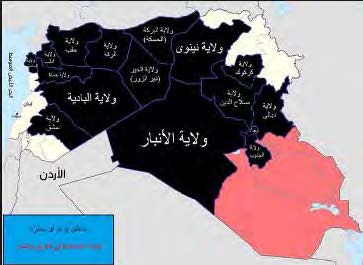
Black indicates the ISIS provinces in Syria and Iraq (Mobtada.com). In reality, ISIS control and influence varies from province to province. Red indicates southern Shi’ite Iraq. White (upper right) indicates northern Kurdish Iraq. White (upper left) indicates southern Syria, Lebanon and the Golan Heights (where ISIS does not have a significant presence).
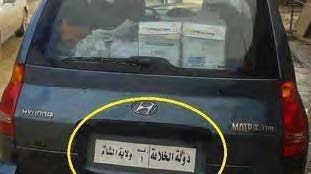
Symbols of ISIS rule in Syria: the picture, uploaded to the social networks, shows a Syrian car with a license place reading “The Caliphate State – Damascus province” (Albawabhnews.com)
Offices of Islamic State institutions (such as the Sharia Council) were established in the various provinces and are run by what are essentially independent representatives. In Aleppo, for example, the governor (wali) is supported by a sharia commander, a military commander and a security commander.[49]
The local ISIS commanders in the various provinces and large cities are called emirs: the emir of Fallujah (Iraq), the emir of the province of Diyala (Iraq), the emir of the city of Al-Raqqah (Syria), etc. Joining ISIS and recognizing the leadership of al-Baghdadi involves swearing allegiance (bay’ah), as was customary at the dawn of Islam and is again customary today (in Saudi Arabia and among the extremist Islamist organizations). New operatives join ISIS at local recruitment offices in the provinces and are trained in camps located throughout them.
ISIS weapons and their sources
Overview
Most of ISIS’s weapons were apparently looted from the Iraqi and Syrian armies. Large quantities of Iraqi army weapons fell into ISIS hands when Mosul was occupied in June 2014.[50] ISIS also received weapons from rebel organizations in Syria or captured them from rebel organizations. In addition, ISIS purchased weapons in Iraq and Syria and abroad. So far, the ITIC cannot map ISIS’s weapons according to their distribution in the provinces controlled by the organization.
According to a study carried out by Conflict Armament Research[51] the weapons captured by the Kurdish forces in Iraq and Syria indicated that ISIS uses captured American army weapons and ammunition. They had been given to the so-called “moderate” rebel organizations in Syria by Saudi Arabia. According to the study, ISIS operatives captured a significant quantity of light American arms including M16 rifles stamped “Property of U.S. Govt. (See pictures). The study also showed that antitank rockets used by the Syrian organizations were the same as the M79 90mm rockets delivered to the Free Syrian Army by Saudi Arabia in 2013. They were manufactured in the 1980s in the former Yugoslavia (Conflictarm.com, August-October 2014). According to the study, ISIS also has ammunition manufactured in Iran between 2006 and 2013 (possibly captured by ISIS from the Syrian army and its supporters, such as Hezbollah).
ISIS has light arms, various types of rockets (standard and locally produced), mortars, anti-tank missiles and launchers, and anti-aircraft weapons. It also has Humvees captured from the Iraqi army during the occupation of Mosul, as well as Toyotas mounted with machine guns.
ISIS also has heavy weapons and advanced technology captured from the Iraqi and Syrian armies. According to media reports issued by ISIS (See below), the organization has tanks, various types of artillery, various types of shoulder-launched anti-aircraft missiles, one or more Scud missiles, one or more MIG-21s, air-to-surface missiles and various types of armored vehicles. It also has mustard gas and possibly other types of gasses it used against the Iraqi security forces and against the Kurds in Ayn al-Arab (Kobanî) (Syria). It has anti-tank missiles including, and according to media reports, advanced Konkurs and Kornet missiles.
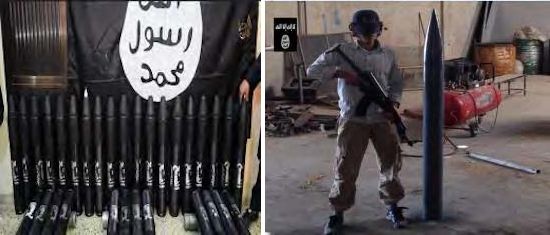
Left: Rockets manufactured by ISIS called “Al-Fatih” (Twitter.com). Right: a “Bin Laden” rocket manufactured by ISIS (Muslim.org)
Tanks and other heavy weapons
ISIS has several dozen Soviet-manufactured tanks. According to a Business Insider report by Jeremy Bender, the tanks ISIS captured from the Iraqi army include 30 Soviet T-55s and between five and ten T-72s (See pictures).[52] It also has selfpropelled artillery and BMP-2 infantry fighting vehicles.
ISIS’s tanks are spread between the various fighting arenas in Syria and Iraq and are targets for aerial attacks by the United States and its allies. Tanks were used in the fighting in Ayn al-Arab (Kobanî).
Planes
At the end of October 2014 ISIS posted a video claiming that an ISIS pilot had flown a MIG in the skies over Aleppo (MEMRI.org, October 25, 2014). ISIS also posted a picture of one of its fighters standing in the cockpit of a MIG-21 (See below). A number of times local residents reported to the London-based Syrian Observatory for Human Rights (SOHR) that they had seen a plane take off from the Al-Jarrah military airfield in the Aleppo province and fly at a low altitude (Syriahr.com, October 17, 2014).[53]
SOHR and an Arabic news site reported that ISIS had taken control of the Syrian air force base of Al-Jarrah, located in the rural region around Aleppo. According to the news site, six planes had fallen into ISIS hands. It was also reported that ISIS was trying to locate professional pilots to fly them. In August 2014 pilots arrived in Al-Jarrah from Iraq and joined ISIS’s ranks (Alaan.tv, October 19, 2014). According to SOHR, there are three air-worthy MIG-21s at the Al-Jarrah airport and one MIG-23. Former Iraqi army officers are reportedly training ISIS fighters to fly them (Syriahr.com, October 22, 2014).[54] There was a media reports that ISIS had at least one Syrian pilot who defected to ISIS.
Centcom commander General Lloyd Austin, asked about ISIS’s aerial capabilities, said “I don’t think that’s currently a significant threat. I know I have some fighter pilots who are hopeful that happens.” (CNN.com, November 7, 2014).

Left: Air to surface missiles seized by ISIS at Al-Tabaqa military airfield. Right: Syrian air force MIG-21 that fell into the hands of ISIS when it took over the airfield (ISIS video, August 26, 2014).
MANPADS (man-portable air-defense systems)
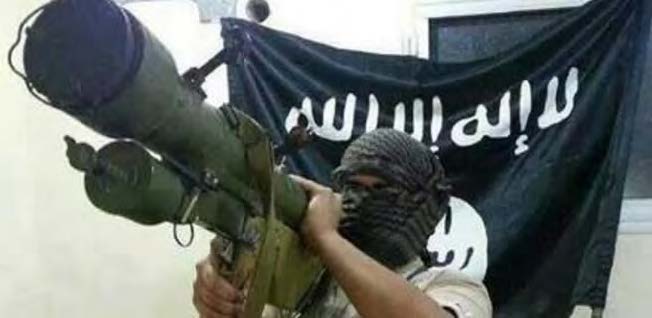
ISIS fighter holds an SA-7 (Strela or similar) anti-aircraft shoulder-launched missile. Behind him is the ISIS flag (Picture from the ISIS Twitter account).[55]
At the beginning of October 2014 the Pentagon announced that as part of its aerial campaign against ISIS the United States would use Apache helicopters on missions to support the Iraqi army and Kurdish forces. Immediately afterwards ISIS used its Twitter account to instruct its fighters how to use anti-aircraft systems called MANPADS (manportable air-defense systems) to intercept them. Previously in September 2014, ISIS posted a video about an Iraqi helicopter in the region of Baiji intercepted by means of Chinese heat-guided MANPADS (Chinese FN-6 MANPADS) (Washingtonpost.com, October 28, 2014; Nytimes.com, October 27, 2014). The missiles may have come from Qatar, Saudi Arabia or the Syrian rebels.
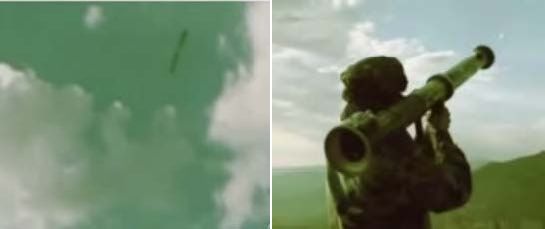
From an ISIS video posted to YouTube documenting an alleged strike on an Iraqi helicopter. Left: A helicopter about to crash. Right: ISIS fighter aims the missile (YouTube). In reality, the video shows an ISIS fighter holding a shoulder-held anti-tank missile launcher. It may have been used to intercept the helicopter.
At the end of October 2014 the German weekly newspaper Bild am Sonntag reported that ISIS had anti-aircraft MANPADS. According to the report, which was based on German intelligence sources, the missiles came from a Syrian army arsenal captured by ISIS. The New York Times reported that the Syrian rebels had had MANPADS since 2012, and that ISIS could acquire such systems (Nytimes.com, October 27, 2014).
It is not known how many anti-aircraft missiles ISIS has in Iraq and Syria. In any event, the fact that ISIS does have them not only endangers Iraqi and Syrian air force helicopters and airplanes, but in the future may also make it difficult for the United States and its allies to use helicopters on special missions. They may also endanger civilian aircraft taking off and landing near Syrian and Iraqi airports. Such weapons systems may also find their way into the hands of jihadi organizations and networks outside Iraq and Syria.
Unmanned Aerial Vehicles (UAVs)
On August 25, 2014, ISIS posted a video to YouTube showing its use of UAVs for monitoring and for gathering intelligence in combat zones in Iraq and Syria. The video, which documented the execution of American correspondent James Foley, also showed aerial photographs of a Syrian army base located in the northern part of the country near Al-Raqqah. A subtitle reads, “Filmed from an Islamic State army UAV” (Ibtimes.com, August 25, year).
On October 27, 2014, ISIS posted a video to YouTube showing captured British correspondent John Cantlie, who reported on the battles in Ayn al-Arab (Kobanî). At the beginning of the video there were pictures allegedly photographed by an ISIS UAV. They were subtitled “Islamic State army UAV” (YouTube, October 27, 2014). Rami Abd al-Rahman, SOHR director, said that ISIS, along with the Al-Nusra Front, was making extensive use of UAVs in Al-Raqqah, the eastern outskirts of Aleppo and Deir al-Zor (Aawsat.net, October 29, 2014).
The videos may indicate that ISIS uses UAVs for monitoring and to collect intelligence. In addition, it shows that ISIS has advanced weapons and technology, which in the past were possessed only by the regular armies of countries (other terrorist organization, such as Hezbollah, also use UAVs).
ISIS’s use of chemical weapons
In October 2014 there were a number of reports in the Arabic and Western media stating that ISIS had used chemical weapons against the Kurdish forces in the fighting at Ayn al-Arab (Kobanî) on October 21 and 22, 2014. It may have previously used them in Ayn al-Arab (Kobanî). According to the symptoms exhibited by victims, chlorine gas, or possible another chemical weapon, had been used. In the past it was reported that ISIS had used chlorine gas in Iraq. Chlorine gas has a long history of military use, first used by the Germans in the First World War.
Reports of ISIS use of chemical weapons in Ayn al-Arab (Kobanî):
On October 24, 2014 the British newspaper The Guardian reported that ISIS was suspected of using chemical weapons in Kobanî. According to one doctor, he treated patients who exhibited burns on all parts of their bodies, burning eyes, respiratory problems, painful throats, vomiting, etc.
- Algerian media sources reported that on October 21, 2014, there was a gas attack in the eastern part of Ayn al-Arab that caused residents to lose consciousness and experience difficulties breathing and/or seeing. In the opinion of one of the doctors, they had been the victims of a chlorine gas or phosphorous attack. One of the victims, who received medical treatment in Turkey, claimed the doctors who treated him diagnosed his wounds as having been caused by a chemical agent. However, doctors in the hospital in Kobanî said they could not state with certainty that chemical weapons had been used (Shorouknews.com, October 22, 2014).
- A Kurdish website called Kurdish Question reported that ISIS had used poison gas in the battles fought in the western part of Kobanî on the night of October 21, 2014.
- A local Kobanî doctor tweeted that he had treated patients after ISIS used poison gas, and he documented his assertion with pictures.
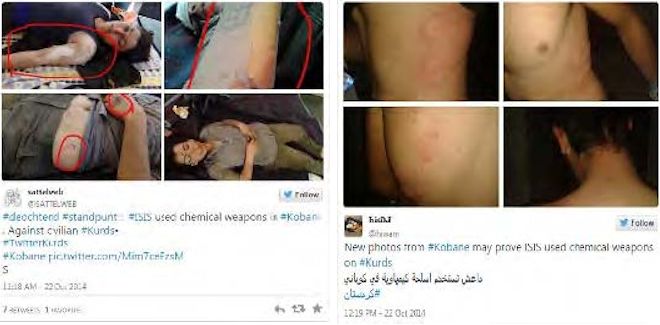
Pictures of wounds taken in Kobanî may indicate that ISIS used chemical weapons against the Kurds. The pictures were posted on the social networks by Kurdish activists (Twitter account of one of the Kurdish activists, October 22, 2014).
Previous information about ISIS’s possession and use of chemical weapons:
- In June 2014 ISIS took control of the weapons storage site at Al-Muthanna, located near the Iraqi city of Samarra, northwest of Baghdad, where chemical weapons had been stored during the Saddam Hussein era. Muhammad Ali al-Hakim, the Iraqi ambassador to the UN, sent a letter to UN Secretary General Ban Ki-moon stating that 2,500 degraded chemical rockets filled decades ago with deadly nerve agent sarin or their remnants were stored along with other chemical warfare agents (Theguardian.com, July 9, 2014). Note: It is generally considered that the chemical substances at Al-Muthanna had deteriorated to the point where they would be useless, and that the rockets for delivering them were not usable. However, improvised pinpoint use could be made of the chemicals stored there.
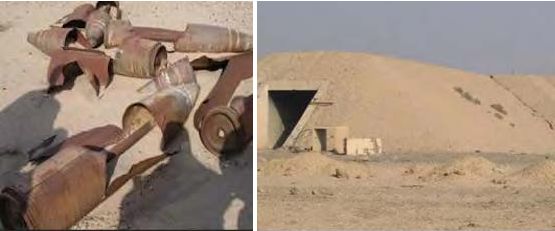
The Al-Muthanna chemical weapons complex captured by ISIS and the weapons found there (Ibtimes.com, CIA.gov, October 15, 2014). Most of the weapons are apparently old and useless.
- In September 2014 it was reported that the Americans were investigating reports that ISIS was using chemical weapons against the Iraqi army. The reports had arrived from the Iraqi army and hospital employees who had treated victims, claiming chlorine gas had been used (Israelnationalnews, October 24 2014).
In conclusion, it is possible that ISIS used chlorine gas at Ayn al-Arab (Kobanî), and possibly another chemical weapon that causes burns, such as mustard gas. Chlorine gas is manufactured extensively and easy to procure. The chlorine gas used by ISIS most likely came from sites it occupied in Syria and Iraq. It is also possible that ISIS bought it on the open market. It was used in Syria and Iraq for local tactical purposes, since it is not lethal and its effect is mainly psychological. ISIS will probably attempt to acquire additional chemical and possibly biological weapons capabilities.
ISIS weapons

Left: Stamp on an M16 rifle taken from ISIS (Conflictarm.com). Right: M79 anti-tank missiles in ISIS possession (Conflictarm.com).
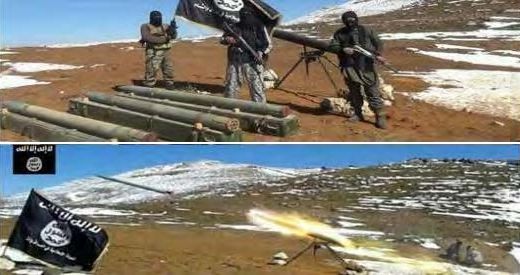
ISIS fighters launch rockets (possibly from Syria) at Brital in Lebanon’s Beqa’a Valley (Twitter, February 2014).

Left: A Scud missile, apparently a Scud D with a range of 700 kilometers (about 180 miles) (State of Al-Raqqah website, June 30, 2014). In ITIC assessment ISIS does not have the capability to launch the missile in the picture (the picture shows the missile’s burned-out electronic and monitoring systems, probably indicating it was displayed in the parade for propaganda purposes only). Right: BMP-2 infantry fighting vehicle in a military display in Al-Raqqah (State of Al-Raqqah website, June 30, 2014).
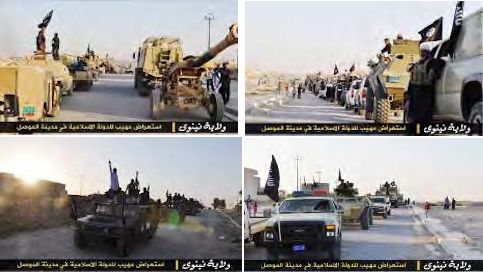
ISIS victory parade in Mosul displaying weapons, armored vehicles and Humvees (Longwarjournal.org, June 24, 2014).
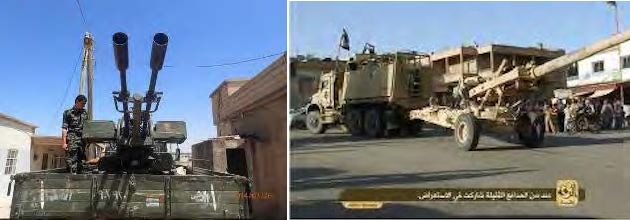
Left: Double-barreled 23mm anti-aircraft gun used by ISIS and captured by the Kurds at Ayn al-Arab (Kobanî) (Conflictarm.com, July 25, 2014). Right: American-manufactured 155mm M198 howitzer in the military display in Al-Raqqah (State of Al-Raqqah website, June 30, 2014)
The leadership
ISIS leader Abu Bakr al-Baghdadi
ISIS is headed by a charismatic Sunni Muslim jihadist named Ibrahim Awad Ibrahim bin Ali al-Badri al-Qurashi al-Samarrai, aka Abu Bakr al-Baghdadi or Abu Du’aa. He is most usually called Abu Bakr al-Baghdadi, named after the Caliph who succeeded Muhammad and was the first of the four Caliphs who established the first Islamic Caliphate (considered Islam’s Golden Age). Abu Bakr al-Baghdadi comes from the Albu Badri clan, the largest in the Samarra region.[56] Many of his relatives are clerics affiliated with radical Salafist-Islam.
Abu Bakr al-Baghdadi is motivated by his aspiration to take over Iraq and Syria and to reestablish the Caliphate state (the Islamic State), which he heads. He took an important step in that direction on June 29, 2014, when he declared himself Caliph of his self-declared Islamic State. On July 5, 2014, in the Great Mosque in Mosul, he was presented as “Caliph Ibrahim, emir of the faithful in the Islamic State.” Al-Baghdadi and his clan regard themselves as descendants of the Prophet Muhammad, members of the Quraish tribe.
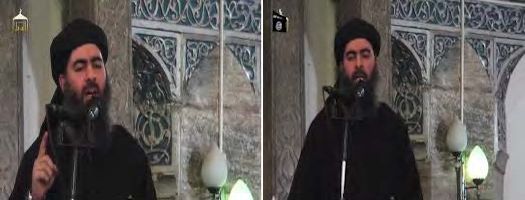
Abu Bakr al-Baghdadi delivers a sermon in the Great Mosque in Mosul on July 4, 2014 (YouTube, July 5, 2014). The pictures are from a video posted partially to dispel rumors that he had been wounded in an aerial attack.
Al-Baghdadi was born in Samarra, Iraq, apparently in 1971. He majored in Islamic studies, apparently at the University of Baghdad, where he received a BA, MA and PhD.[57] Before Saddam Hussein was overthrown he was a young, devout Muslim, and often went to the mosque to pray (Liberation.fr, June 12, 2014). According to information from the Iraqi administration, he taught Islamic studies at a university, apparently the University of Baghdad and was the Imam of a mosque in Samarra and after that in Fallujah (Alarabiya.net).
After the Americans entered Iraq in 2003, al-Baghdadi, who had collaborated with Abu Musab al-Zarqawi, headed small jihadi networks. He became the leader of a jihadi organization called Majlis Shura al-Mujahideen. It was one of the organizations that fought the Americans in Iraq and joined ISI. In 2006, after the establishment of ISI, he joined the leadership and became its religious authority. After the killing of ISI’s two leaders in April 2010 he inherited the leadership. Despite the fact that his expertise was in Islamic studies, he acquired extensive military experience during his continuing activity against the American forces in Iraq. In October 2011 the American State Department designated him a terrorist operative and put a price of $10 ten million on his head, dead or alive.
The December 16, 2013 issue of Time Magazine had an article about Abu Bakr al-Baghdadi that included an interview with an ISIS fighter from Homs who was recuperating from a wound, staying in a safe house in Tripoli, Lebanon. He said he had known al-Baghdadi in 2004, when he was in a training camp in the Diyala province of Iraq. He was there, he said, with hundreds of the Syrian jihadi fighters who were streaming into Iraq at the time to fight the Americans. He said he remembered that al-Baghdadi spoke infrequently, made sure his men were safe and concerned himself not only with attacks but also with how to withdraw his men when necessary. He added that al-Baghdadi usually hid his face with a scarf and never revealed secrets.
Abu Bakr al-Baghdadi was detained by the Americans in Fallujah in 2004. He was taken to the Bucca detention camp on suspicion of supporting Al-Qaeda. In 2009 he was rendered to the Iraqi administration, which decided to release him, however. In May 2010, shortly after his release, he was appointed ISI leader (replacing Abu Omar al-Baghdadi, who had been killed by the Americans in April 2010). Beginning on April 9, 2013, after the unification of ISI and the Al-Nusra Front (the Syrian branch of Al-Qaeda) was declared, al-Baghdadi became the leader of the united organization called ISIS and was therefore was expelled from Al-Qaeda, which was led by Ayman al-Zawahiri.
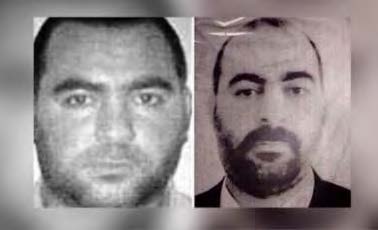
Pictures of Abu Bakr al-Baghdadi disseminated by the Iraqi government (apparently taken when he was in prison).
The American media described al-Baghdadi as a capable, talented leader. The Washington Post, quoting an American intelligence official, called him “the true heir to Osama bin Laden, “saying he was “more violent, more virulent, more anti-American” than Ayman al-Zawahiri (Washingtonpost.com, June 10, 2014).[58] According to Time Magazine, one example of his ability to plan and command was the central role he played in breaking into the Abu Ghraib prison on July 21, 2013. At the time the Arab media reported that he was the one who had planned the Abu Ghraib operation and that it had not been the first operation he orchestrated to release Al-Qaeda prisoners from Iraqi jails.
On November 9, 2014, the Iraqi media reported that Abu Bakr al-Baghdadi had been wounded in an American aerial attack on the city of Al-Qaim in western Iraq near the Syrian border. Other senior figures were reported killed or wounded in the same attack. ISIS spokesman Abu Muhammad al-Adnani admitted that al-Baghdadi had been wounded and asked that people pray for his speedy recovery. The extent of his injuries is not currently clear. However, to refute rumors of his death, on November 13, 2014, ISIS posted an audio recording of a 17-minute speech given by Abu Bakr al-Baghdadi (Al-Minbar Al-I’lami Al-Jihadi forum, November 13, 2014).
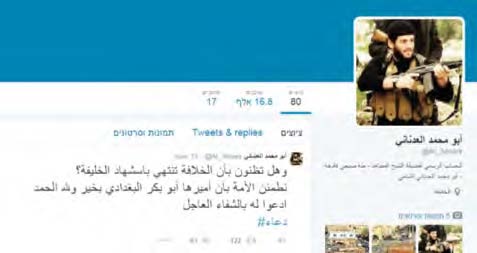
Abu Muhammad al-Adnani tweet from November 9, 2014. The Arabic reads, “Do you think the Caliphate will end with the martyr’s death of the Caliph? We comfort the [Islamic] nation with [the news that] its emir, Abu Bakr al-Baghdadi, feels well, thanks to Allah. Pray for his speedy recovery” (Twitter.com).
Other senior commanders
ISIS is secretive and compartmentalized regarding the full names of its commanders and their commands, especially those in senior roles. The turnover is rapid, whether because of organizational reasons or because commanders die or are wounded in battle. For that reason the copious amounts of information issued about ISIS commanders and their commands cannot be considered exact or current and should be examined carefully.
Some senior ISIS commanders, some of whom were killed in battle, are the following:
- Tarkhan Tayumurazovich Batirashvili, aka Omar al-Shishani (the Chechen) or Abu Omar al-Shishani — A Chechen operative from Georgia who served as a sergeant in the Georgian armed forces and was a prominent ISIS military commander in northern Syria. He is described by the Islamic State as military commander.[59] The ITIC cannot verify that information. He was born in 1986; his father was Christian and his mother was a Chechen Muslim. In 2012 he went to Syria where he joined the ranks of the Al-Nusra Front and commanded the “Emigrant Army” unit (composed of foreign fighters from Chechnya and other countries). At the end of 2013 he and some of his men defected from the Al-Nusra Front and joined the ranks of ISIS. He swore allegiance to Abu Bakr al-Baghdadi, who appointed him commander of northern Syria.[60] On a number of occasions it was reported that he was killed, but that cannot be verified.[61]
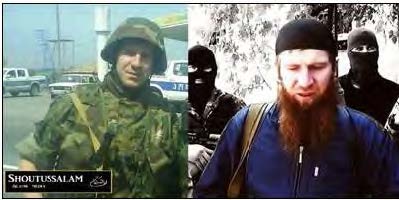
Left: Abu Omar the Chechen as a sergeant in the Georgian army. Right: Abu Omar the Chechen (Voltarinet.org)
- Taha Sobhi Falaha aka Abu Muhammad al-Adnani al-Shami — A senior ISIS operative of Syrian origin, he fought against the American army in the ranks of the Majlis Shura al-Mujahideen, a jihadi organization led by al-Baghdadi. He was detained by the Americans and imprisoned between 2005 and 2010. He is the ISIS spokesman and was reported to be in charge of all operations in Syria at the start of 2013, and is believed to be a member of the Shura Council.[62] As a propagandist he is highly productive and exploits his closeness to Abu Bakr al-Baghdadi (often posts videos and speeches presenting the organization’s positions). It was al-Adnani who on June 29, 2014, declared the establishment of the Islamic Caliphate in the areas under ISIS control in Syria and Iraq. On November 2, 2014, the media reported he had been wounded in an Iraqi air force aerial attack in the al-Qaim region of Al-Anbar province (All4syria.info, November 2, 2014).
- Waleed Jasem Mohammed al-Alwani, aka Abu Ahmed al-Alwani — A former captain in Saddam Hussein’s army, and also a Ba’athist. He was previously the Council’s military commander and before that responsible for the Diyala province. He is currently believed to head the Military Council.[63] According to an unverified report (Vetogate.com), he was killed in Iraq’s Salah al-Din province.
- Adnan Latif Hamid al-Sweidi (or al-Sweidani) aka Abu Muhanad al-Sweidi or Abu Ayman al-Iraqi — A senior ISIS military operative in Syria and ISIS commander in Idlib, Aleppo and the Latakia mountains. He was formerly a Ba’athist and close associate of Izzat al-Douri, a senior figure in Saddam Hussein’s regime. During the Saddam Hussein era he was a lieutenant colonel in aerial defense intelligence. He was detained by the Americans in 2007 and released in 2010. After his release he was made head of ISIS security. In 2011 he transferred to Syria where he was made responsible for operations in western Syria. While in Syria he reportedly recruited 1,000 fighters who swore allegiance to Abu Bakr al-Baghdadi (Alarabiya.net). At some point he was the governor of Al-Anbar province. He has a wide reputation for almost pathological violence.[64]
- Adnan Ismail Najm al-Bilawi, aka Abu Abd al-Rahman al-Bilawi or Abu Usama — Born in 1971, was a captain in the Iraqi army during the Saddam Hussein era. Like several other senior ISIS operatives he was detained in Camp Bucca, the American detention facility. He headed ISIS’s Military Council and was a member of its Shura Council. He lived in Al-Khalidiya in Al-Anbar province (Alarabiya.net). He died in a raid on his home by Iraqi security forces on June 5, 2014. The campaign to take over Mosul, launched immediately after his death, was named in his honor, and the detailed long-term planning for the operation was likely to have been his responsibility.[65]
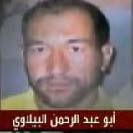
Abu Abd al-Rahman al-Bilawi; photograph issued by the Iraqi ministry of the interior (Alarabiya.net)
- Alaa’ Abd al-Wahhab al-Razouq al-Mashhadani aka Abu Bilal or Hajj Bakr — A colonel in the army during the Saddam Hussein era. He is described as Abu Bakr al-Baghdadi’s right-hand man. Commands Al-Anbar region for ISIS (Alarabiya.net).
ISIS’s Sunni allies
Overview
ISIS is not the only military organization fighting in the campaigns against the regimes in Iraq and Syria. However, its political situation is different in the two countries:
- In Iraq ISIS is supported by a coalition of Sunni Muslim organizations that increased the number of its supporters within the Sunni population. ISIS is the dominant military power within the coalition and spearheads the military campaign it began in the summer of 2014.
- In Syria ISIS is an important rebel organization, one of many fighting the Assad regime. It usually does not collaborate with the other rebel organizations except on its own terms, and therefore its relations with them are tense. Some of them regard ISIS as potentially dangerous to themselves and as damaging to the campaign against the Syrian regime, and feels they will have to deal with it sooner or later. There is particularly sharp rivalry between ISIS and the Al-Nusra Front, Al-Qaeda’s branch in Syria, manifested in the past by clashes between them. However, the rivalry was temporarily shelved when President Obama announced his anti-ISIS campaign.
Iraq
The Sunni Muslim coalition in Iraq supporting ISIS includes organizations whose ideologies and objectives are different from those of ISIS, but they are united in their hostility to the Shi’ite-affiliated Baghdad regime. The organizations include Sunni tribesmen from northern and western Iraq, Ba’ath activists and Iraqi army officers who formerly supported Saddam Hussein, jihadi groups that do not belong to ISIS (such as Ansar al-Islam)[66] and members of a Sufi Islamic opposition organization called the Naqshabandi Order.”[67]
Support for the coalition is manifested by the widespread hostility of the Sunni population to the Shi’ite-affiliated Baghdad regime. The current regime represents the structural change that began in Iraq’s political system with the entrance of the Americans (end of the rule of the Sunni minority, establishment of a Shi’ite regime supported by Iran, establishment of the Kurdish autonomous region). The Sunni coalition, centering around ISIS, participated in the takeover of Fallujah in January 2014 and in the attack on Mosul and other regions in northern Iraq in June 2014.
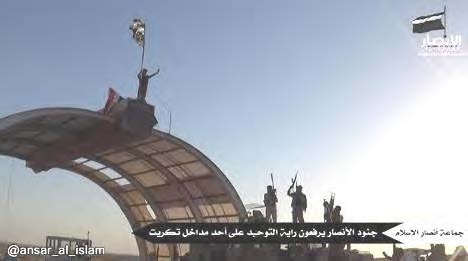
Ansar al-Islam fighters wave its flag (“The flag of the faith in the oneness of Allah”) at one of Tikrit’s gates (from an Ansar al-Islam tweet, according to Longwarjournal.org, June 23, 2014).
Important members of the Sunni coalition are the tribes in western Iraq, whose support ISIS gained during the past year. During the takeover of Fallujah at the beginning of 2014 a tribal network called “the revolutionaries of the tribes in Iraq” supported ISIS. In Al-Anbar province there were reports of a tribal network called “the revolutionary rebels of the Al-Anbar tribes” that collaborated with ISIS. In the past there were reports that the networks were headed by a former Iraqi army officer named Husam al-Din al-Dulaimi (YouTube). A tribal network called “the military council of the revolutionary tribes” was also mentioned.
However, there are Sunni tribes, which cooperate with the Iraqi army and are opposed to ISIS. ISIS makes an example of them by treating them brutally. For example, an ISIS forum (Alplatformmedia) posted a series of pictures on August 29, 2014, showing corpses lying on the ground in an urban setting. The explanation was that they were 46 “apostates” Sunni Muslims from the Albu Nimr tribes from the Iraqi city of Hit, taken over by ISIS. According to the ISIS announcement, they were executed because they had collaborated with the Iraqi army. An ISIS supporter wrote on the forum that the pictures also included members of the Iraqi security forces.
Albu Nimr is one of the largest and most important tribes in Al-Anbar province, the center of ISIS’s power in Iraq. At least some of its members collaborated in the past with the Americans and the Iraqi regime against Al-Qaeda forces operating in the province. According to the Iraqi administration, the order for the slaughter was given by the ISIS governor of Al-Anbar. An estimated 400 tribesmen in Al-Anbar province were murdered by ISIS: 46 in Hit, 250 in Albu Asaf near Ramadi, 30 in the Bir Zawiya region, and 75 at Al-Tharthar lake (Alarabiya.net). A tribal head reported on November 2, 2014, that so far 500 of his tribesmen had been slaughtered by ISIS. He claimed that the tribe did not receive assistance from the Iraqi government or any other agency to be able to cope with those who carried out the slaughter, whom he called terrorists (Arabic.rt.com).
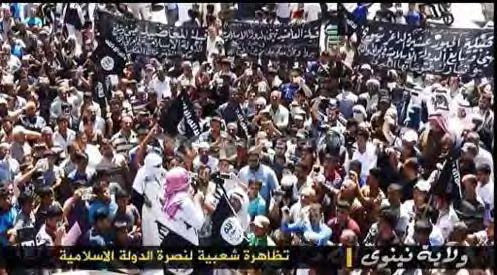
Demonstration held by Sunni tribesmen in the Nineveh province in support of the declaration of the Islamic State (YouTube)
The support of the Sunni tribes is important because they are the basis for ISIS’s popular support in Iraq, although at the same time their military forces and religious-ideological fervor are less that those of ISIS (which as noted is the main military factor in the Sunni coalition). The Sunni tribes support ISIS primarily because they are hostile to the Baghdad Shi’ite-affiliated regime and not because they share a jihadi ideology or have extensive mutual interests. When the circumstances change, for example, when a regime arises in Baghdad that meets their political demands and calms Sunni fears, the current coalition may disintegrate. In addition, ISIS’s brutality, continued over time, may also alienate the tribesmen and the entire population.
Former Iraqi military personnel and Ba’ath activists
Officers who served in the Iraqi army during the Saddam Hussein era and Ba’ath activists are prominent within the leadership of the Islamic State. Their collaboration with ISIS began during the fighting against the American army when ISI emerged from the branch of Al-Qaeda in Iraq. Many of the organization’s commanders with a Salafist-jihadi worldview found themselves in Camp Bucca, the American detention camp, along with army officers and Ba’ath activists. While imprisoned they formed personal relationships which helped both sides join forces in the years before the Americans withdrew from Iraq; they continue collaborating to this day.
The unholy alliance between Salafist-jihadi operatives and pan-Arab, secular, socialist Ba’ath activists is, in ITIC assessment, a marriage of convenience from which both sides profit. The Islamic State makes use of the military and bureaucratic skills of the army and party members, in which it is severely lacking. On the other hand, the Ba’athists and former Iraqi army personnel found a safe and convenient framework from which to fight the central Shi’ite-affiliated administration in Baghdad, the United States and the West. The common denominators for the jihadists and Ba’athists are their strong objection to the Shi’ite-controlled Iraqi nation state and their desire to establish a supranational country in which Sunni Muslims would rule.
ISIS’s Kurdish operatives
In the wake of ISIS’s military successes, in the first half of 2014 Kurdish fighters joined the organization, increasing ISIS’s potential threat to the Kurdish regional autonomy (which is not Islamist) in northern Iraq. According to the Kurdish authorities, an estimated 150 young men, about a third of them from the city of Halabja,[68] had joined ISIS during the first half of 2014. In addition, according to a Kurdish intelligence agent, 52 Kurds from Halabja joined the fighting in Syria, most of them enlisting in ISIS. One of them reached a position of command in ISIS and served in its front line outside the city of Kirkuk (Washingtonpost.com, June 24, 2014). In addition, a Kurdish jihadi organization called Ansar al-Islam, is also a member of the coalition supporting ISIS. However, there are few such expressions of support and there is great fundamental hostility between ISIS and the Kurdish autonomous region, and between ISIS and the Kurds in Syria. That is evidenced by the battles between ISIS and the Kurds in northern Iraq in the summer of 2014, as well as the battles against the Kurdish forces in Kobanî, Syria.
After the battles in Al-Arab (Kobanî), ISIS was supported by dozens of Kurdish fighters, most of them from Halabja. An Iraqi correspondent, Ms. Dana Jalal, said there were 70 Kurds fighting in the ranks of ISIS. One of the most prominent was a senior fighter nicknamed Abu Khattab the Kurd, who came from Halabja and who had served in Ansar al-Islam. Shorsh Hassan, YPG spokesman in Kobanî, said most of the jihadi Kurdish forces fighting in the ranks of ISIS came from Iraq, most of them from Halabja; some of them were from Syria (AP.org, November 4, 2014).
Syria
ISIS strives to gain the support of the Sunni tribes in eastern Syria, although in ITIC assessment it apparently needs them less than those in Iraq. In Syria as in Iraq, the Sunni tribes collaborate with ISIS based on interests which are not particularly profound and may change in the future. Power struggles between ISIS and the tribes are evidenced by ISIS’s executions and slaughters of members of the al-Shu’aytat tribe in the region around Deir al-Zor, carried out when the tribe attempted to restore its control over several villages (Al-Akhbar.com, August 12, 2014). In November 2014 there were reports that al-Shu’aytat tribesmen who had fled from ISIS had joined the Syrian regime and begun training in the Tadmor region (ancient Palmyra); other tribesmen fled to Turkey (zamanalwsl.net, November 8, 2014).
Following the declaration of the Caliphate ISIS wanted the tribal heads in Syria to swear allegiance to Abu Bakr al-Baghdadi. At the beginning of July 2014 a large meeting of provincial tribal dignitaries was held at the Al-Farouk dam in the region of Manbaj, to the northeast of Aleppo. The meeting was addressed by the ISIS operative responsible for the tribes in the Aleppo province. He said that it was a religious duty to swear allegiance to the Caliph, required of every Muslim under the control of the Islamic State. He called on the tribal heads to motivate their tribesmen to wage jihad “for the sake of Allah” to topple the Syrian regime. He spoke of the Islamic State’s military and economic achievements and the services it provided for the population. After he spoke the tribal heads swore allegiance to Abu Bakr al-Baghdadi, “the emir of the faithful.” Then dinner was served after which they practiced shooting weapons at the Syrian flag and dummies of Syrian president Bashar Assad (Twitter account of ISIS in the Aleppo province, July 10, 2014).
On September 7, 2014, ISIS’s media bureau in Aleppo posted a video to YouTube showing 30 Kurdish villagers in the northern area of Aleppo swearing allegiance to ISIS. An ISIS spokesman could be heard telling them that ISIS was the brother of Muslim Kurds and fighting for the sake of Muslims. He added that ISIS was not fighting the Peshmerga and PKK forces because they were Kurds but because they were “infidels” who wanted democracy and secularism.
Financial capabilities
Overview
ISIS is the richest terrorist organization in the world. It took over most of the oil and gas fields (6-8 oilfields) in Syria and several oilfields in Iraq. Its main source of revenue is the profit it makes from marketing petroleum products, estimated at several million dollars a day. Other sources of revenue include various criminal activities, collecting taxes from local residents or demanding protection money, demanding head taxes from non-Muslims, donations from the rich and ransoming captives. Following the aerial attacks by the Americans and their allies which focused on ISIS’s oil refineries, its oil profits declined to about $1 million a day (Theguardian.com, October 30, 2014).
Thus ISIS is an extraordinary example of a terrorist organization that acquired quasi-national financial capabilities though military success. The large sums of money flowing into its coffers every month liberate it from dependence on Al-Qaeda and donors in the Arab-Muslim world, and provide it with financial independence. That enables it to increase the number of its fighters, feeds the momentum of its military successes, allows it to establish alternative governmental systems in its self-declared Caliphate State and to wage an intensive battle for hearts and minds throughout the world to glorify its reputation and increases its capabilities.
Changes in ISIS’s revenues: from donations to financial independence
In the past ISIS was based on financial aid from rich individuals in the Arab world who supported Al-Qaeda, especially donations from the Gulf States. Initially, when it was founded in Syria, the parent organization in Iraq gave financial aid to its Syrian branch, the Al-Nusra Front. Al-Nusra Front leader Abu Muhammad al-Julani, when swearing allegiance to al-Zawahiri, did not forget to thank Abu Bakr al-Baghdadi for “giving us part of the money from the [Islamic] State [in Iraq] despite the difficult time it had experienced.”
After ISIS was expelled from Al-Qaeda, a move that may have hurt the revenues, which came from external donors, the organization began to find independent sources of revenue in the territories it took control of and to establish its influence in Syria and Iraq. Its sources of revenue came mainly from the oilfields under its control or influence. It has additional sources, including criminal activity, such as smuggling, bank robbery, the takeover of banks in Mosul, stealing antiquities and selling them on the black market, extorting businessmen, confiscating the property of its opponents and various other felonies.[69] Other sources include levying taxes on residents living in ISIS-controlled areas, donations from rich individuals among its Sunni allies and ransom for captives (usually $2 million for Western captives).
Abducting captives to hold for ransom is a familiar terrorist organization tactic, also practiced by Al-Qaeda and the terrorist organizations operating in Yemen and North Africa. ISIS has received millions of dollars in ransoms. According to David S. Cohen, US Treasury Undersecretary for Terrorism and Financial Intelligence, so far in 2014 ISIS has received at least $20 million in ransom. According to the British newspaper The Guardian it has received $45 million in ransom (Theguardian.com, October 30, 2014).
Thus today ISIS is financially independent and no longer finds it necessary to rely on donations. According to Richard Barrett, in mid-2014 its assets were calculated at between $1.3 and $2 billion. Documents seized from the house of Abdulrahman al Bilawi in June 2014 suggested that the Islamic State had around $875 million in cash and assets before the fall of Mosul. It is widely reported that the group seized up to an additional $430 million from the Central Bank in Mosul and other financial institutions.[70] Its revenues and assets make it unique among terrorist organizations (including its parent organization, Al-Qaeda) and enable it to grow rapidly and develop its military, governmental and media infrastructures.
ISIS takeover of oil and gas fields in Syria and Iraq
During its takeover of eastern Syria in 2013-2014 ISIS took control of most of the oil and gas fields. At the beginning of July 2014, the rebel organizations in eastern and northern Syria (See map) announced that ISIS had taken over the large oilfield of Al-Omar. During the attack in Iraq in the summer of 2014, other oilfields and facilities fell into ISIS hands. It took control of the main refinery on the outskirts of Mosul, the principal supplier of electricity for Baghdad (Almoslim.net). ISIS then tried to take over the oil city of Baiji (northeast of Baghdad), which has Iraq’s most important refinery and related facilities, but so far its efforts have proved unsuccessful.
Today ISIS controls most of the oilfields in Syria and others in Iraq. The Financial Times quoted a recent report from the risk management firm of Maplecroft, stating that that Isis now controlled six out of 10 of Syria’s oilfields, including the Al-Omar facility, and at least four small fields in Iraq, including those at Ajeel and Hamreen (Ft.com, September 21, 2014).[71] According to “oil experts” quoted by the daily Al-Quds Al-Arabi on September 25, 2014, ISIS took control of six oilfields in Syria and of seven oilfields and two refineries in Iraq. Each of the two refineries in Mosul produces 16,000 barrels of oil a day.
ISIS controls a number of gas fields in Syria containing 45% of the country’s gas reserves. At this point it cannot produce gas, and therefore the profits are insignificant. ISIS continues its attempts to take over other gas fields. On September 29, 2014, ISIS announced that large parts of the Shaer gas field, located about 110 kilometers, or about 70 miles, from the city of Homs, had fallen into its hands. It posted pictures of the gas field and weapons it seized there. However, on November 14, 2014 it was reported that clashes still continued at the Shaer gas field[72] (Syriahr.com, November 14, 2014). At the beginning of November 2014 ISIS took over the Jahar gas field, located in the rural area around Homs. According to reports, the Syrian army restored its control of the gas field after clashes with ISIS (Rt.com, November 5, 2014). The situation on the ground in those areas is still unstable.
ISIS’s estimated revenues
According to various estimates, ISIS receives several million dollars a day from the sale of petroleum products, that is, close to $100 million a month (updated to September 2014). Its profits increased significantly in the summer of 2014 after it took control of Mosul and other areas of northern Iraq, and established itself in eastern Syria. However, the aerial attacks of the Americans and their allies on ISIS’s oil refinery facilities in Syria hurt its ability to refine and market petroleum products and decreased its oil revenues to about $1 million a day.
Estimates from various sources:
- According to a senior Israeli intelligence officer, ISIS’s revenues are between $3 and $6 million a day (Ynetnews.co.il, September 18, 2014).
- According to an American army estimate, ISIS sold refined oil from the refineries attacked by the Americans at the end of September 2014 for about $2 million a day (Centcom.mil, September 14 and 24, 2014). According to David S. Cohen, US Treasury Undersecretary for Terrorism and Financial Intelligence, ISIS earned close to $1 million a day from selling petroleum products, as of mid-June 2014.
- According to the Iraqi Energy Institute, ISIS controls the production of 30,000 barrels of crude oil a day in Iraq and 50,000 barrels in Syria. It is sold on the black market at the reduced price of $40 a barrel (as opposed to $90 a barrel on the free market). As a result, ISIS earns $3.2 million dollars a day from the sales, or almost $1.2 billion dollars a year.[73]
- According to Masrour Barzani, head of the intelligence apparatus in the Kurdish autonomous region of Iraq, ISIS’s daily revenues are estimated at $6 million. The money comes from the sale of oil and wheat, the levy of taxes in the occupied cities, ransom and donations (Shafaaq.com, September 22, 2014).
- According to the British newspaper The Guardian, October 30, 2014, ISIS earns $1 million a day from the sale of oil.
- In “The Islamic State” Richard Barrett quotes estimates according to which oil production from facilities under ISIS control is between 30,000 and 80,000 barrels a day. He notes that even selling the oil at the heavily discounted price of $25-$50 per barrel would provide daily revenues of $2-$4 million (p. 52).
However, recently its revenues have been reduced and may be reduced further because of the aerial attacks on its refinery facilities and the pressures exerted on its customers.
ISIS’s estimated expenses
ISIS pays monthly salaries to an estimated 25,000 operatives, costing the organization between $200 and $600 per operative, according to the operative’s nationality and family size. ISIS also has to maintain the logistics of its military forces. Monthly salaries for administration personnel vary between $300 and up to $2,000 for senior management positions.[74]
In addition ISIS invests large sums of money in the civilian infrastructure of the local populations and in maintaining the governmental and organizational systems it established in Syria and Iraq (its media and public relations systems, for example). However, in ITIC assessment, its revenues, even after the American attacks reduced it, far exceed its expenses.
ISIS’s petroleum products
ISIS produces oil from the oilfields under its control using the existing refining infrastructure and at dozens of improvised refineries. Some of the petroleum distillates are used for internal purposes and some are “exported” to the local markets in Syria, Iraq and the Kurdish autonomous region. The Arab media have reported several times on understandings reached between ISIS and the Syrian regime regarding the smuggling of oil from the areas under ISIS control to areas under Syrian regime control.[75]
According to expert estimates, the oil-smuggling network ISIS currently uses has existed for decades. It includes northern Iraq, northeastern Syria, southern Turkey and parts of Iran. It began in the 1990s when the Iraq regime tried to circumvent the energy sanctions imposed on it by the UN. Black market oil is often refined in Iraqi Kurdistan while the Kurdish autonomous administration looks the other way, the result of the tension between the Kurdish leadership and the Baghdad regime (Ft.com, September 21, 2014).
According to David S. Cohen, US Treasury Undersecretary for Terrorism and Financial Intelligence, ISIS sells its oil “at substantially discounted prices” to a variety of middlemen, including some from Turkey, who resell it to other customers. Some of it is sold to Kurds in Iraq and from there it is transported to Turkey. The Syrian government has also made arrangements with ISIS to purchase oil.[76]
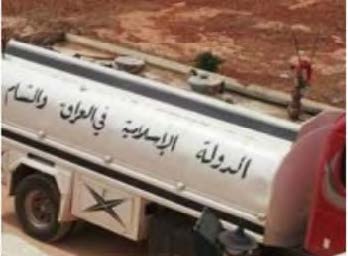
ISIS oil tanker bearing the inscription “The Islamic State in Iraq and Greater Syria” (Alhadathnews.net)
ISIS control of the national infrastructure
In addition to its control of oil and gas, it controls other facets of the national infrastructure:
- ISIS controls three hydroelectric power plants and one thermal power plant in the regions of Aleppo and Al-Raqqah in northern Syria.
- After ISIS took over Mosul, it was reported that it took control of the city’s Central Bank and the funds deposited in it (estimated at $420,000). Apparently ISIS also took over funds deposited in other banks in Mosul.
Sale of souvenirs
ISIS and its supporters also sell souvenirs, for both propaganda purposes (to brand ISIS in the West) and as a source of revenue. CNN reported that there were Facebook pages promoting the sale of ISIS shirts. Other sites were found selling or promoting the sales of ISIS souvenirs:
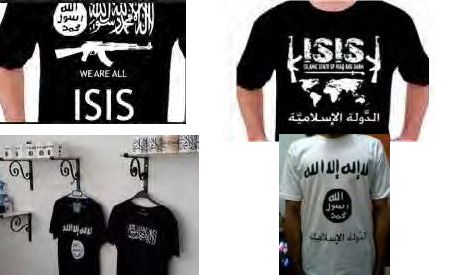
Upper left: “We are all ISIS” shirt (Facebook). Upper right: ISIS shirt showing the extent of its aspirations (Rialayoum.com). Lower left: ISIS shirts and mugs (Alarabalyawm.net). Lower right: Islamic State shirt (Tunisiatimes.tn)
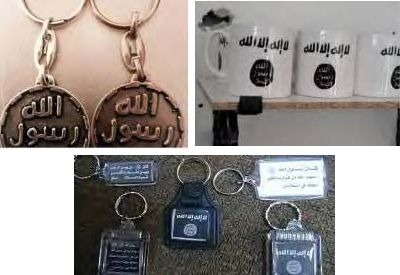
Upper left: ISIS key chains (Alarabalyawm.net). Upper right: ISIS mugs (Alarabalyawm.net). Bottom: ISIS key chains distributed in Al-Raqqah (Minbar-alansar.blogspot)
![]()
[1] Links to all other nine sections:
You can read the overview — “ISIS: Portrait of a Jihadi Terrorist Organization” — here.
You can read section 1 — “The historical roots and stages in the development of ISIS” — here.
You can read section 2 — “ISIS’s ideology and vision, and their implementation” — here.
You can read section 3 — “ISIS’s military achievements in Iraq in the summer of 2014 and the establishment of its governmental systems” — here.
You can read section 4 — “ISIS establishes itself in eastern and northern Syria” — here.
You can read section 6 — “Exporting terrorism and subversion to the West and the Arab world” — here.
You can read section 7 — “ISIS’s propaganda machine” — here.
You can read section 8 — “The American campaign against ISIS” — here.
You can read section 9 — “ISIS response to the American campaign (update to mid-November 2014)” — here.
![]()
Notes:
[39] Until June 2014, Western estimates made public in the media put the number of ISIS operatives at between 11,000 and 15,000. For example, according to an investigative report published on June 12, 2014 in the French daily Libération, about 5,000 ISIS operatives participated in the June attack in Iraq, while it was estimated that there were 6,000-7,000 ISIS operatives in Syria. According to the British daily Financial Times on June 19, 2014, in June ISIS had about 15,000 fighters. According to the American political website The Hill on September 11, 2014, the CIA estimated ISIS’s strength at 10,000. On the other hand, Fuad Hussein, Chief of Staff to Massoud Barzani, president of the Kurdistan Regional Government, claimed that the CIA’s estimate was incorrect and that in reality ISIS had at least 200,000 operatives (Independent.co.uk, November 17, 2014). The ITIC is of the opinion that the number is vastly inflated.
[41] In this context, the Islamic title emir is given to the head of an Islamic organization or state. The emir, according to the original Islamic concept, has exclusive authority over civilian, religious and military matters. An emir can also command military forces. The title Emir al-Mu’minin is important because it gives whoever bears it Islamic legitimacy (for example, the King of Morocco also bears the title). The heads of contemporary extremist Islamist organizations are also called emirs.
[42] Richard Barrett, Senior Vice President, “The Islamic State,” The Soufan Group, November 2014.
[43] Also called the General Military Council (al-majlis al-askari al-‘aam).
[46] Barrett, “The Islamic State,” p. 30.
[47] According to a September 2014 study by the Terrorism Research and Analysis Consortium (TRAC), al-Baghdadi has a kind of “cabinet” of experienced military personnel. He appoints them, they are subordinate to him and report directly to him. According to Barrett, “The Islamic State,” there are councils with different areas of responsibility (security and intelligence, finances, provincial matters, etc.)
[48] Wilayah (province) was the usual term for province during Islam’s first Caliphates. It was also used by the Ottomans. Muhafaza (governorate) is the modern term used by the nation states today. ISIS uses the Islamic-based term.
[49] Barrett, “The Islamic State,” p. 34.
[50] According to Al-Arabiya TV (October 3, 2014), ISIS took possession in Mosul of 50 tanks, 150 APCs, hundreds of trucks 60,000 rifles and Scud surface-to-surface missile.
[51] A British organization that identifies and tracks conventional weapons and ammunition in contemporary armed conflicts “Islamic State Weapons in Iraq and Syria,” September 2014. Dispatch IS Iraq Syria Weapons.
[55] The independent Iraqi TV news channel Al-Sumaria reported that ISIS fighters in Al-Anbar and Salah al-Din provinces had begun using Strela shoulder-launched anti-aircraft missiles. They were transferred from Syria to Iraq (Alsumaria.tv, October 8, 2014).
[56] The Albu Badri is an Arab Iraqi clan, the largest in the region of Samarra. It has a number of branches, some of which live in Baghdad, southern Iraq and Diyala province. Among the Albu tribe in southern Iraq are those who adopted Shi’a. However, in the Samarra region they are Sunnis. When the American army was in Iraq, they suffered at the hands of the Jaish al-Mahdi Shi’ite militia headed by Moqtada al-Sadr. Abu Bakr al-Baghdadi comes from the al-Sada branch of the clan, with households in Samarra, Baghdad, Amara and Aquba. The al-Sadas are considered the descendants of the Prophet Muhammad and therefore their religious status is high (Samaracity.net).
[57] According to media reports, he studied at the Islamic University in Baghdad, apparently in the Islamic studies department. Alternately, he may have studied at the Saddam Hussein Islamic University.
[59] Barrett, “The Islamic State.”
[60] For further information see the May 2014 bulletin “Foreign fighters from various countries and regions in Asia, fighting against the Syrian regime, most of them in organizations affiliated with Al-Qaeda and the global jihad.”
[61] In 2014 he led ISIS an attack on rebels in Deir al-Zor. The media reported that he was killed in the clashes. According to a report from the Kurdish Peshmerga, he was killed in a Kurdish attack at the Mosul dam. On November 13, 2014, an Iraqi news website reported his death (Alsumaria.tv, November 13, 2014). Chechen President Ramzan Kadyrov recently used his Instagram account to announce that Omar the Chechen had died (Arabic.rt.com). All the above information has not been verified.
[62] Barrett, “The Islamic State,” p. 58
[63] Ibid., p. 36.
[64] Ibid., p. 37.
[65] Ibid., p. 36
[66] A Kurdish jihadi organization where al-Zarqawi sought refuge when he arrived in Iraq. The organization is active in northern Iraq (Kirkuk and Tikrit) to this day. For further information see “Ansar al-Islam claims attacks against Iraqi military, police” (Longwarjournal.org, June 20, 2014).
[67] While Sufi orders are generally not involved in politics or warfare, this order did send operatives to fight in various locations, for example, the revolt of the Imam Shamil (1830-1859), a Chechen leader in Russia, who headed the order.
[68] Where in 1988 Saddam Hussein used chemical weapons against the Kurdish civilian population.
[69] An ISIS video filmed on August 11, 2014, and uploaded on September 21, 2014 showed millions of dollars in cash and gold bars. ISIS claimed they had been seized in the house of the chairman of the Iraqi parliament, Osama al-Najaifi (MEMRI.org, September 22, 2014).
[70] Barrett, “The Islamic State,” pp. 50-51.
[72] According to the November 13, 2014 edition of the Lebanese newspaper Al-Akhbar, the attack on the Shaer gas field was intended to paralyze it and damage the Syrian regime. When the Syrian army retook the gas field it became apparent that it had in fact been paralyzed, causing a lack of gas and damaging its ability to produce electricity, whose production was based on both oil and gas. According to the newspaper, the Syrian political leadership was unprepared for the attack in view of the increased demand for electricity and fuel that would be felt in the coming winter. Talal al-Barazi, the governor of Homs, said that at the beginning of November the city received only 60% of the fuel it needed.
[73] Paul Rivlin, “Money makes the world go round,” Iqtisadi: Vol.4, No. 9 (Sept. 28, 2014) The Moshe Dayan Center for Middle Eastern and African Studies. dayan.org.
[74] Barrett, “The Islamic State,” p. 50.
[75] French Foreign Minister Laurent Fabius said France had proof that ISIS had transferred oil from areas under its control to the Assad regime (Arabnews.com, July 1 2014).
[76] From a lecture given by David Cohen on September 23, 2014, “Attacking ISIL’s Financial Foundation,” Carnegie Endowment for International Peace. carnegieendowment.org.



 RSS
RSS




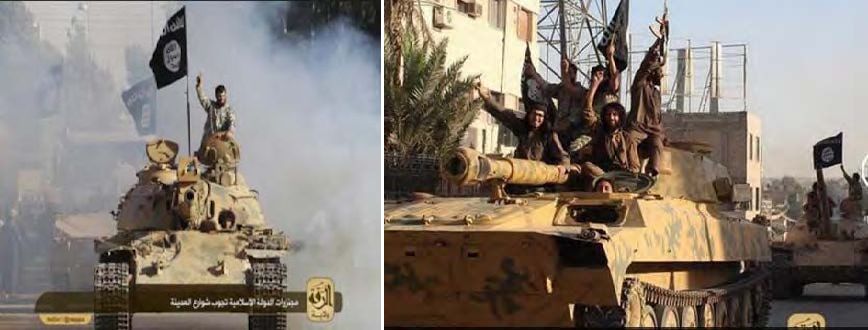
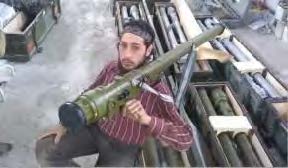
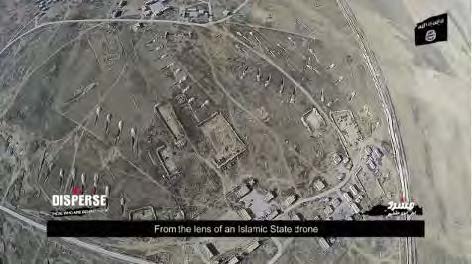
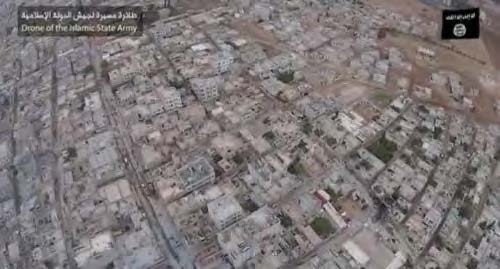

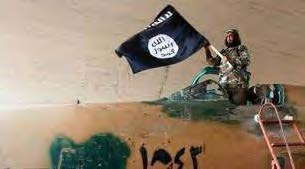
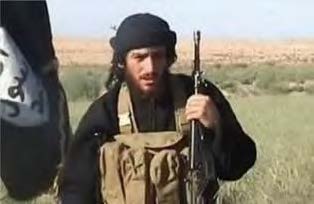

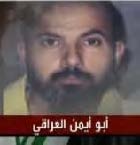

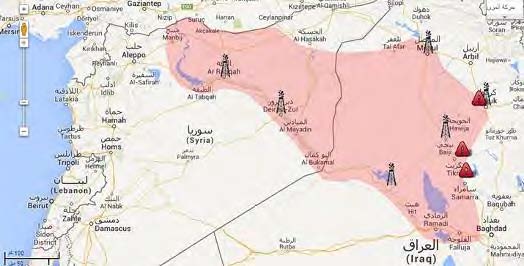
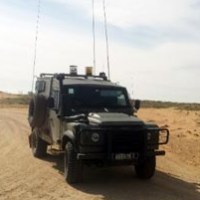
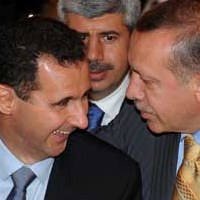
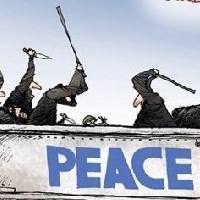
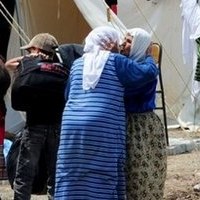
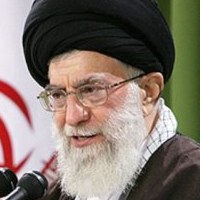




Latest Comments
Hello Mike, Thank you for your positive feedback to the article. I felt there wasn’t too much critical analysis of ...
Thanks for this considered and well constructed article. A follow up article on the manner in which the editorial contro...
THE CLUELESSNESS OF CLAIMING THAT OBAMA'S MIDDLE EAST POLICIES WERE A FAILURE CANNOT BE FURTHER FROM THE TRUTH, WHAT THE...
As long as Obama is the president of the usa do not trust the us government......
Thank you for an good read....